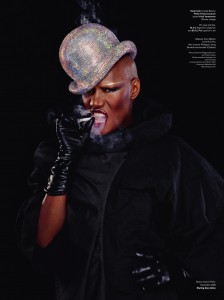

Vanity Fair - kd lang and Cindy Crawford
Stealing Beauty was a panel discussion chaired by Diva magazine Editor Jane Czyzselska. I was on the panel with Artist, DJ and performer Sadie Lee and fashion historian and cultural critic Elizabeth Wilson.
The event explored how LGBT culture plunders dominant straight culture and uses it to create something new and vibrant.
In my presentation I brought up three concepts. And here is a sample of my talk.
- The Guerilla Gaze
- Analog Duplication of Dominance
- Dominant Dilution
The Guerilla Gaze
My definition of The Guerilla Gaze is the ability of LGBT people to derive pleasure from images not intended for us. We queer the

Grace Jones - still looking fabulous
images in our imagination subverting the inherent (hetero)sexuality of the dominant narratives presented in movies, music videos, adverts and TV shows. In movies highly femininised women become objects of desire for women, as well as objects of identification. Butch lesbians may model their image according to the “thug style” as seen by hip hop stars like Fifty Cents or Flo Rida. They sometimes mimic the pose presented by the brute force of masculinity of Brad Pitt in Fight Club or Marlon Brando in A Street Car Named Desire usually in a vest.
The Guerilla Gaze also throws light on people within film or TV narratives or within culture who are not considered objects of desire by mainstream heterosexual commodified desire. Our eyes are drawn to men and women who are “othered”. We elevate women in particular who defy the odds – who are older yet fierce, who bend gender, who are rebels. Do we do this because we feel they are the “Ugly Ducklings” of mainstream culture, and in our eyes they are transformed into Swans as we would hope to be perceived?
Analog Duplication of Dominance
The definition of analog duplication of dominance is that oppressed peoples often steal traditions from dominant cultures and with time the original meaning often changes or is subverted. I say this because with each generation our memories become increasingly more faint to the point that contemporary people often do not know the origins of particular behaviours, images, styles and traditions. Our collective memories are thus analog. If our memories were digital we would remember everything accurately all the time.
In the USA the system of the Houses eulogised in the movie Paris is Burning, recreates the notion of nuclear family with House Mothers and Fathers and children. Houses are made up of queer African American and Latina Americans rejected by mainstream LGBT cultures or their own bio-families. The Houses host balls in which people parody or mimic images of (WASP) power in the USA. For example one of the categories is Executive Realness. The participants perform “Business man” but always with flair. They cannot resist that extra flourish and transpose beauty and colour over the drabness of a grey suit. Popular gay slang now refers to LGBT people being “one of the children” or “family” possibly not realising their origins in Houses in the ghettos of the USA in the 1980s.

Fem - Eve relishes the apple
My work especially Fem is about stealing iconic images of femininity from dominant culture including fairy tales, religion, movies, fashion. I queer them with a particular lesbian sensibility – Eve does regret eating the apple and will not be punished. Eve is also a Black woman, reminding us that we all came from Africa and subverting the dominant Eurocentric Biblical image of Eve.
Dominant Dilution
Mainstream straight culture sucks off cultures of marginalised peoples, and regurgitates it back to everyone bleached and ironed out for mass capitalistic consumption.

August 1993 issue of Vanity Fair with k.d. lang and Cindy Crawford
Words like naff whose original meaning was dull, heterosexual, mundane or trade meaning same sex partner were from Polari the language spoken by LGBT people and people in the underworld in the past. Prince gained major popularity in the 1980s but how many people know that his style was very similar to Little Richard from the 1960s who sang songs with coded queer lyrics. Madonna appropriated vogueing a dance style created by queer African American and Latina Americans for her video Vogue, while not mentioning anyone of colour in her homage list.
Sometimes, very rarely, a queer image, created by a queer person, with a queer sensibility is used by a mainstream company to sell their product. This happened once with the Vanity Fair which had on their 1993 cover, kd lang and Cindy Crawford photographed by Annie Liebovitz. If you can think of any others please let me know. The image is particularly interesting because it is gender queer, and kd lang a butch woman is also being used to sell glamour to a straight audience.






![Reblog this post [with Zemanta]](http://web.archive.org./web/20120106214801im_/http://img.zemanta.com/reblog_e.png?x-id=977fe2df-63f7-4045-b339-8e2128e0edbb)





![Reblog this post [with Zemanta]](http://web.archive.org./web/20120106214801im_/http://img.zemanta.com/reblog_e.png?x-id=c93b6611-1c4e-48a5-aa5f-3b7354eaea9c)


![Reblog this post [with Zemanta]](http://web.archive.org./web/20120106214801im_/http://img.zemanta.com/reblog_e.png?x-id=15c1b6c7-6afc-42b1-b4b7-4ba57aad52e9)